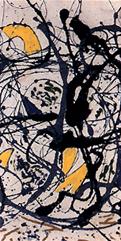|
From March 1999 the Tate Gallery is to host the first retrospective exhibition of the work of Jackson Pol lock held in Britain for more than forty years. Widely considered to be the most challenging and influential American painter of the twentieth century, Pol lock was one of the primary creators of modern art after the Second World War. The exhibition is organised by The Museum of Modern Art, New York, and the Tate Gallery is its only European venue. It will offer a remarkable opportunity to see in full the work of this extraordinary and controversial artist. Born in Cody, Wyoming, in 1912, Pollock endured a turbulent childhood in Arizona and California before moving to New York in 1930. By the early 1940s he attracted critical attention with his images of figures and animals, painted with violent intensity. In 1947 he arrived at the style that made him famous. Drawing on a wide range of historical and contemporary cultural sources, Pollock developed a radically new way of painting. Dripping paint from a brush or stick held above the canvas, he wove webs of interlacing lines, punctuated with puddles and spatters of colour, creating images of stunning richness and complexity. With their combination of all-over composition, gestural paint handling and total abstraction, his mature works of 1947-50 announced the emergence of Abstract Expressionism, the art that swept the globe in the decade that followed, wresting from Europe its dominance of modern art As his peer and rival Willem de Kooning, said 'Jackson broke the ice.'
 1948 Tate Gallery © 1999 Pollock-Krasner Founation ARS, NY and DACS, London 1999
In August 1949 Life magazine ran a feature on the thirty-seven year old Pollock, headlined 'Is he the greatest living painter in the United States?' and hailing him as 'the shining new phenomenon of American art'. His premature death in a car crash in 1956 set the seal on the legend of Pollock, while marking the start of ever growing critical acclaim and influence on subsequent generations of artists. Seen as the quintessential tortured genius or artiste maudit, he became a cultural icon who has been compared to others of his time such as James Dean, MarIon Brando, Charlie (Bird) Parker and Dylan Thomas. Because of the large scale and fragility of many of Pollock's most important paintings there have been few major exhibitions of his work since his death. This exhibition, organised by Kirk Varnedoe, Chief Curator of Painting and Sculpture at The Museum of Modern Art, with Pepe Karmel, Adjunct Assistant Curator, will contain approximately eighty paintings and drawings from major private and public collections worldwide. Among the outstanding and exceptional loans will be Pol lock's last masterpiece, the legendary Blue Poles: Number 11, 1952, from the National Gallery of Australia. Also rarely seen is Mural, 1943, his first wall sized painting, made for Peggy Guggenheim. The full maturity of his art in the classic 'drip' paintings, is represented by several large scale masterpieces, including Number 32, 1950 and Number 31, 1950. |
|